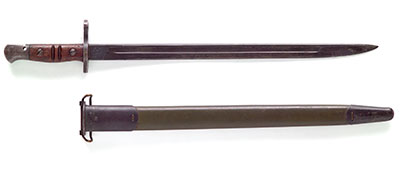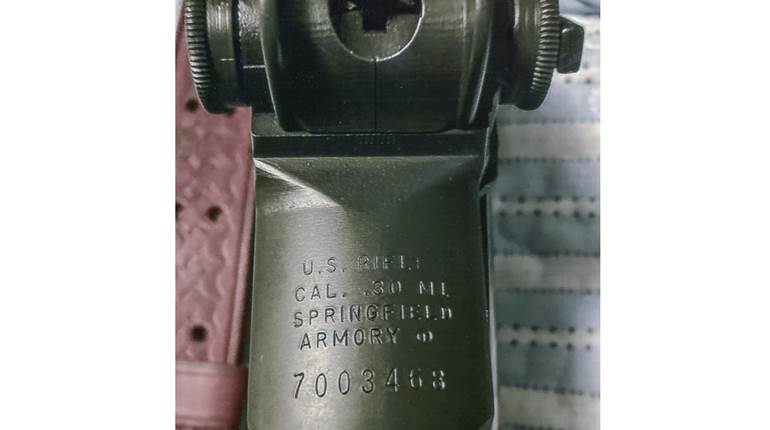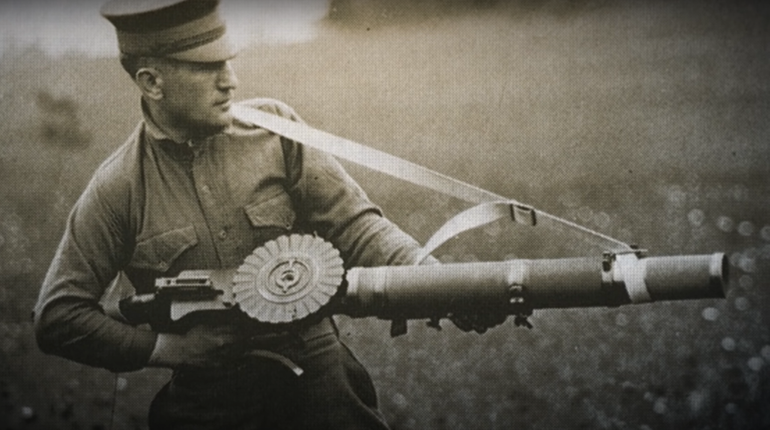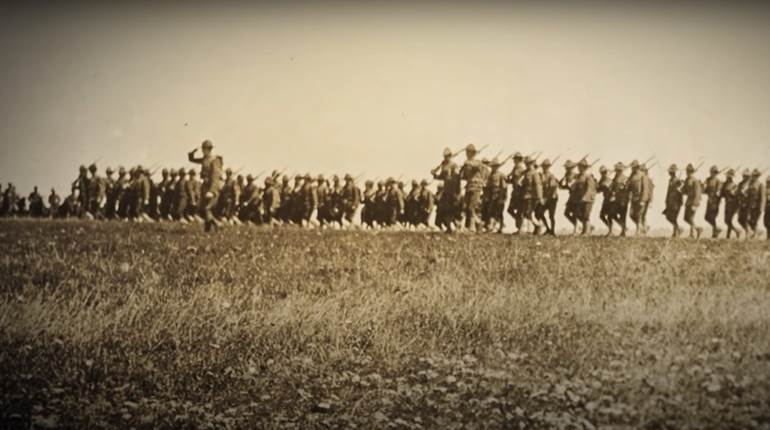

In April 1917, when the United States was faced with active involvement in the war raging in Europe, our military lacked many of the essential arms necessary to fight the determined and experienced enemy. One of the most pressing deficiencies in Uncle Sam’s arsenal was service rifles. While the standard U.S. military rifle at the time was the excellent Springfield Model of 1903 (July 2018, p. 48), there were only some 600,000 on hand, far short of the number necessary to arm the rapidly expanding American military.
Springfield Armory immediately took steps to increase manufacture as rapidly as possible. Rock Island Arsenal had manufactured the Model 1903 rifle from 1903 until 1913, when its rifle production program was discontinued. Rock Island began preparations to revitalize its moribund ’03 rifle assembly line, but the shortage of experienced personnel and the lack of raw materials hampered efforts in this regard. It was painfully obvious our armed forces would soon be facing a crippling shortage of modern service rifles unless other steps were taken. Some 160,000 obsolete U.S. .30-40 Krag rifles were taken out of mothballs, primarily for use as training rifles for the flood of recruits and draftees inundating training camps across the country, but this was only a stopgap measure. Clearly, another source of rifles needed to be found, and time was of the essence.
The War Dept. had two basic options for the procurement of additional rifles. One was to seek commercial manufacturers that could produce Model 1903 rifles under government contract. It was soon determined, however, that the lag time required to find suitable manufacturers, negotiate production contracts, train new workforces from scratch, and acquire the necessary production machinery and raw materials would be too great. The second option would be to adopt another type of rifle that was already in production to augment the Model 1903. Ultimately, the government had little choice but to pursue the second option.
The fates of war smiled on the United States at that time, as there was an available source of rifles. Three American firms—Winchester, Remington and Eddystone (an affiliate of Remington)—were completing the manufacture of large numbers of Pattern 1914 .303 British bolt-action rifles for the British government. The machinery and trained workforces were still largely intact, and the three firms could resume production of the Pattern 1914 rifle for the United States with little delay.
Despite this fortuitous situation, the War Dept. was immediately faced with another conundrum. In order to put the maximum number of rifles into the hands of our armed forces in the minimum amount of time, the government initially considered adopting the .303 British Pattern 1914 rifle “as is.” That course of action, though, would have resulted in logistical headaches, as it would have required two types of ammunition to be produced and issued. Also, it was widely believed that the British .303 cartridge was inferior to the American .30-’06 Sprg. Those considerations resulted in a decision to modify the British rifle to be chambered for the standard American .30-cal. cartridge.

The modified rifle was adopted as the “U.S. Rifle, Caliber .30, Model of 1917,” sometimes referred to today as the “Pattern 1917” or “P17” rifle. This nomenclature is factually and historically incorrect, as the U.S. military never used the term “Pattern” or “P” to designate arms. The official nomenclature was either “Model of 1917,” “Model 1917” or “M1917.” The rifle is also widely called the “U.S. Enfield” or, sometimes, just the “Enfield.” It is interesting to note that a 1942 field manual (FM 23-6) was titled “U.S. Rifle, Caliber .30, M1917 (Enfield).”
The Model 1917 rifle weighed 9 lbs., 3 ozs., with a 26" barrel, and it had an overall length of 46 1/4". The rear sight was a folding leaf, adjustable for elevation, but not windage. The magazine capacity was six rounds, although it was typically loaded with the same five-round stripper clip as the Model 1903 Springfield rifle.
The Pattern 1914 bayonet was also adopted by the United States as the “Bayonet, Model of 1917.” The bayonets were manufactured by Winchester and Remington, but, for whatever reason, none were made by Eddystone. Some of the Pattern 1914 bayonets made for the British were procured by the U.S. military and over-stamped with American martial markings.
 When it was announced that the new rifle had been adopted, the War Dept. received some criticism due to the delay in procuring the badly needed rifles because of the time it would take to finalize the engineering procedures involved in the change from .303 British to .30-’06 Sprg. In retrospect, this was unquestionably the correct decision. In 1919, Assistant Secretary of War Benedict Crowell stated, “The decision to modify the Enfield was one of the great decisions of the executive prosecution of the war—all honor to the men who made it.”
When it was announced that the new rifle had been adopted, the War Dept. received some criticism due to the delay in procuring the badly needed rifles because of the time it would take to finalize the engineering procedures involved in the change from .303 British to .30-’06 Sprg. In retrospect, this was unquestionably the correct decision. In 1919, Assistant Secretary of War Benedict Crowell stated, “The decision to modify the Enfield was one of the great decisions of the executive prosecution of the war—all honor to the men who made it.”
Immediately after its adoption, the three manufacturers began preparations to convert from Pattern 1914 production to manufacture of the Model 1917 as expeditiously as possible. On May 10, 1917, each manufacturer submitted a prototype sample of the modified rifle to Springfield Armory for evaluation. Even though, from an engineering and technical aspect, converting from .303 to .30-’06 wasn’t particularly difficult, it was determined there were problems with each of the rifles. One of main issues was lack of interchangeability of components due to the fact that some of the parts on the prototype rifles were hand-fitted. Even with the pressing need for rifles, the Ordnance Dept., understandably, insisted that the parts be interchangeable and instructed each maker to improve their manufacturing techniques before going into mass production.
On July 12, 1917, the manufacturers submitted a second sample rifle to Springfield. Each sample reflected some degree of improvement, but it was determined that more refinement was needed. The Ordnance Dept. gave each company the option of proceeding with quantity production while working on the interchangeability issues or delay manufacture until the problems could be rectified. Remington and Eddystone elected to delay production, but Winchester chose to proceed without delay. As events transpired, Winchester should have been a bit more judicious. Assistant Secretary of War Benedict Crowell later remarked: “It would have been well if the same course of action [wait for final specifications] had been followed at the Winchester plant, for word came later from Europe not to send over any rifles of Winchester manufacture during that period.”

It should not be inferred that the Winchester-made rifles were not functional, but, rather, the interchangeability issues caused logistical problems for Ordnance units in France. Even though the troublesome interchangeability problems were never completely resolved, once the standardized engineering drawings and specifications were completed, an acceptable rate of 95 percent interchangeability of parts was achieved by all the manufacturers. The later Winchester Model 1917 rifles were equal in quality and interchangeability to those made by the other two makers. It is interesting to note that unlike Remington and Eddystone, very-early-production Winchester Model 1917 rifles (approximately the first 5,000) were marked on the receiver ring with just the initial of the maker—“W”—as was the case with the British Pattern 1914 rifles, but that was soon changed to the full name “Winchester.”
There was a perception by some that the newly adopted rifle was not suitable for use by our military. As an example of that mindset, there was an article published in the New York Times titled, “Why our forces in France must use an inferior rifle.” The article stated a number of misleading, if not outright false, “facts” regarding the Enfield. The magazine Arms And The Man, predecessor to The American Rifleman, subsequently published an article that refuted the New York Times’ flawed piece and detailed the valid reasons for the adoption of the Model 1917 rifle.

While both the Model 1917 and Model 1903 rifles were bolt-actions, there were several differences in the design and operation of each. One of the most apparent was the Model 1917’s aperture rear sight, which was mounted above the receiver and located closer to the eye than the ’03’s barrel-mounted, folding-leaf Model 1905 sight.

Another obvious difference was the U.S. Enfield’s distinctive “crooked” bolt handle, which was designed for faster manipulation of the action. While it may have had some slight advantage in this regard, it is amusing to note that an Ordnance Dept. report vastly overstated rapid-fire advantages of the configuration of the bolt and stated “by bending the bolt, we placed two men on the firing line where there was only one before.”
In addition to the design of the rear sight and the shape of the bolt handle, another difference was the fact that the British rifle had a “cock-on-closing” bolt-action mechanism unlike the ‘03’s “cock-on-opening” design. While it didn’t have any definitive impact on the operation of the rifle, many of the American troops who had become accustomed to the ’03 found this feature of the Model 1917 to be somewhat annoying.
Another less noticeable difference was the fact that, unlike the ’03, the Model 1917 lacked a magazine cut-off. Again, this wasn’t a serious drawback, as magazine cut-offs were rarely used in combat. The lack of the feature meant that the follower had to be manually depressed in order to close the bolt on an empty magazine, which could prove a bit awkward during close-order drill. In order to be able to close the bolt without having to manually depress the follower, some Doughboys would insert a dime to keep the follower depressed. While obviously a makeshift measure, it worked. Later, stamped sheet metal magazine-follower depressors were introduced.
Some of the complaints were due to lack of familiarity with the rifle, but the Model 1917 was indeed heavier and bulkier than the trim ’03, and this resulted in a majority of infantrymen of the American Expeditionary Force preferring the Springfield although they were issued 1917s. On the other hand, the Model 1917 was strong and reliable, and while its accuracy may not have been equal to the ’03s pinpoint target capability, it was more than adequate for most combat applications.
In addition to its role as an infantry rifle, as was the case with the Model 1903, a number of Model 1917 rifles were fitted with French-designed Vivien-Bessiére rifle grenade launchers which proved to be handy devices for trench warfare.

As the war progressed, the combined output of Model 1917 rifles produced by the three commercial firms greatly exceeded Springfield Armory’s and Rock Island Arsenal’s Model 1903 production. It is estimated that about three-quarters of the AEF was armed with Model 1917 rifles at the time of the Armistice. Ordnance Dept. records indicate 1,123,259 Model 1917 rifles had been shipped to France prior to the cessation of hostilities. The vast majority of these rifles were acquired by the U.S. Army, but limited numbers were also procured by the U.S. Navy and U.S. Marine Corps, although the Model 1903 remained the predominant rifle used by the latter two branches of service. The Model 1917 remained in production until mid-1919, by which time a total of 2,422,529 rifles had been manufactured.
In the immediate post-World War I period, the War Dept. was faced with a decision as to which rifle, the Model 1903 or the Model 1917, would be designated as “Standard” and which would be deemed “Substitute Standard.” There were sound arguments to be made for either. The Model 1917 had proven to be a very serviceable infantry rifle and was available in large numbers. On the other hand, the excellence of the Model 1903 was unquestioned. It was also pointed out that the ’03 was manufactured by government-owned and -operated facilities, so any potential future production of the rifle would not be affected by labor strikes or similar problems that might arise with commercial manufacturers. The naïve, but pervasive, sentiment following the “War To End All Wars” was that soldiers were likely to spend more time on the target range than the battlefield. Thus, the Model 1903’s superiority as a target rifle was seen as one of the reasons in the decision to retain it as “Standard” and most of the Model 1917s were consigned to the war reserve stockpile. Of course, the illusion of perpetual peace was shattered just a couple of decades later.
During World War II, the Model 1917s were called back into service and used by the American armed forces for training purposes and limited use as supplementary service rifles. Also, large numbers were distributed to some allied nations under various military aid programs. After 1945, substantial numbers of Model 1917 rifles were sold via the Office of the Director of Civilian Marksmanship (DCM), and some have even been offered through the Civilian Marksmanship Program in more recent years. Many rifles were subsequently “sporterized” by the civilian owners for hunting. The large number of rifles given away to allied nations and the practice of sporterizing resulted in unaltered Model 1917 rifles being surprisingly scarce today relative to the number manufactured.
When considering the important U.S. military rifles of the 20th century, the “American Enfield” is sometimes overlooked. With the centennial of America’s active combat involvement upon us, the historical significance of the Model 1917 is finally being recognized and the rifle given its rightful place in American military ordnance history. While it may not have been the first choice of many Doughboys, the Model 1917 rifle nevertheless provided valuable service to our fighting men when no other was available. That’s not a bad legacy for any rifle.






































